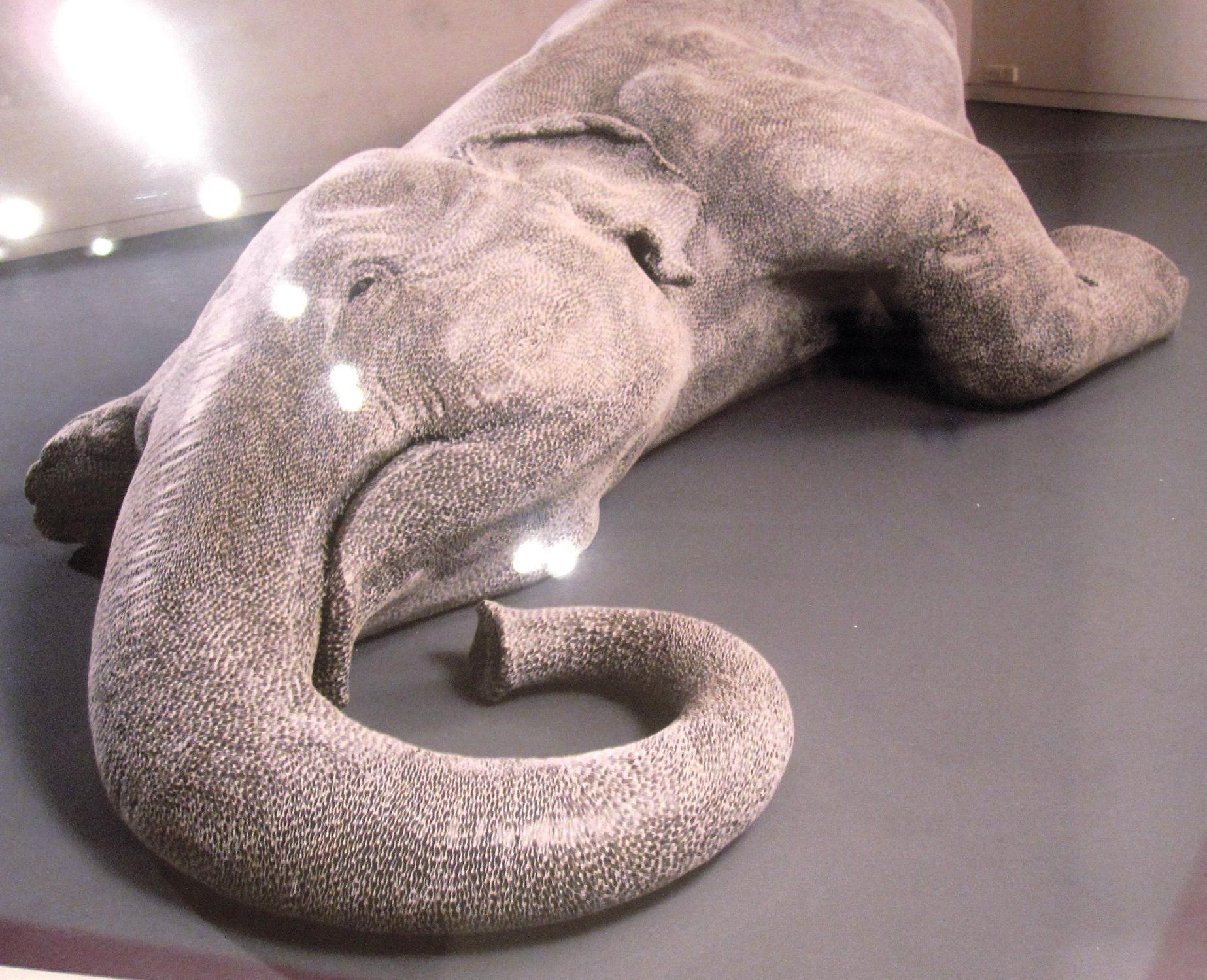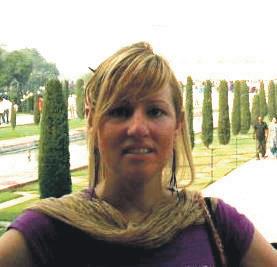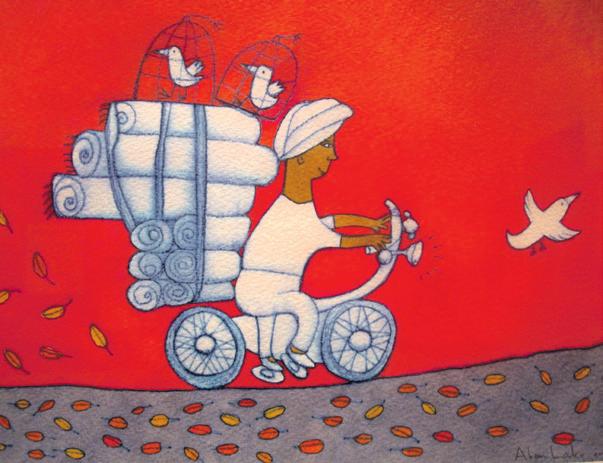
4 minute read
Feast of kindness revealed
from 2012-07 Sydney (2)
by Indian Link
In the heart of Melbourne, just a hop and skip from Melbourne Central Station is the RMIT Gallery, which has the honour of exhibiting a collection of 117 different artists and writers from India and Australia. The gallery setting for the Kindness/Udarta exhibition is compact, but the small space is undeniably jampacked, much like India. Each artist involved has provided a snapshot of their work, a small insight into a bigger picture. Each artwork in a way describes just one ingredient of the many that go to make up India, or Australia, or both. Looking closer into any of these works can reveal the larger story behind the artist’s creation, and reveal tales of experiences they wish to share. The stories behind the works are absorbing and inspiring, and are available in a hardcover publication produced in conjunction with the exhibition.
I left the exhibition with a smile, because many of the works reminded me of the daily things often taken for granted in Australian and Indian lives. These things are those that give our world character, and are what we love and miss most about a place when we leave it.

The Kindness/Udarta exhibition is a celebration of 20 years of work, and marks the 20th Anniversary of the AustraliaIndia Council, (AIC). The artists and writers participating in the exhibition are only some of many who have been recipients of an AIC-funded grant. These grants have been awarded to persons or groups to help with projects that reflect the values of the AIC. The exhibition is thus, in a sense, a semi-historical account of 20 years of meaningful work that has been supported by the AIC.
The AIC was formed in May 1992, thanks to the then Senate Standing Committee on Foreign Affairs, Defence and Trade, who identified a need for such a group. The organisation’s primary intention has been to promote Australian and Indian relations, collaboration and connections, understanding and respect, and knowledge, skill and cultural exchange. It participates, encourages and promotes related activities, and supports many of these each year through the provision of AIC grant funds awarded in India and Australia for projects in fine arts, literature, film, sport, education, science, technology, environment, and public health. In addition, grant recipients are also likely to have had personal experience in both India and Australia, and are conscious of elements of both cultures. Through supporting these projects, the AIC is actively working toward maintaining and improving Australia-India connections and where possible, building long term and ongoing connections.
The Kindness/Udarta exhibition is on show until August 25 in Melbourne, with a special cultural event of music and dialogue from participating artists (and more) on August 2. Prior to being presented in Melbourne, this collection of works was presented at the Visual Arts Gallery, at the India Habitat Centre, New Delhi, where it received great reviews. Likewise, the response was also good in our National Capital, Canberra.
Over 117 visual artists and writers from Australia and India have participated in the exhibition, from which many are notably accomplished in their field, and very well known in creative circles. These include Australian Thomas Keneally, a novelist and playwright who is renowned for his book Schindlers Ark which was later adapted into the film Schindlers
List
Alexis Wright is an Indigenous Australian writer of both nonfiction and fiction, who has notably been a recipient of the Miles Franklin literary award in 2006 for her novel Carpentaria

Les Murray is a multi-award winning poet, well known for writing about rural life in Australia, with down-to-earth characters. He is regarded an Australian Living Treasure, a designation bestowed by the Australian National Trust.
Robyn Beeche is a photographer of fashion and culture, based in northern India since 1985, capturing images of Indian festivals and daily life through her camera. Finally, Callum Morton is an installation artist, also showcasing his work at the exhibition.
The Indian artists contributing include Haku Shah, an artist specialising in rural and tribal arts, and an anthropologist of traditions and folklore. He is renowned for his art, and for establishing a tribal museum at Gujarat Vidyapith, in Ahmedabad
Prasad is a Rajasthani potter, well known for creating double-fired pots in colours of the sunset, in grey blues and in charcoal black. Giriraj learned pottery at the age of 8, and still practices and teaches his family trade almost 60 years later. He assisted with the installation of Indian style furnaces into the Australian Art Schools, for the benefit of sharing his art. Giriraj received the National Award for Excellence in Terracotta Pottery in India in 1987.
Nalini Malani is a multimedia artist living in Mumbai, with her works incorporating colourful drawings, paintings, performance, animation and film. Themes of her work are often based on unheard and forgotten stories of ostracized and overlooked people.

Bharti Kher is a contemporary artist born to Indian parents in the UK, but who now lives in India. Her works are often large, colourful, and immensely detailed. They include large sculpture, paintings and installations. Themes of her art relate to Indian customs contrasted with western values, repression of women in India, and contemplation of the value of traditional roles and rituals in India.
Shilpa Gupta likewise, is also an interdisciplinary artist. She works with video, photography and performance and often involves audience participation to enhance the meaning of her work. She challenges the audience to think about the themes of her work. Her themes largely relate to consumer culture, militarism and human rights.
There are so many more accomplished artists and writers on show at this event, all of whom have engaging and interesting works of art, with thought-provoking stories behind them on display.
I will conclude with an excerpt from a passage on display at the exhibition, taken from a work by Barbara Brooks’ Verandas, putting your head under water and listening. Being in India is like driving in the dark. The headlights illuminate only part of the landscape at a time, and then you are swallowed by the unknown. I rattle along, never sure where I’m going, and people talk to me out of kindness. I ask questions, listen, then go away with more questions.’
The artists and writers participating in the exhibition are only some of many who have been recipients of an AIC-funded grant\










